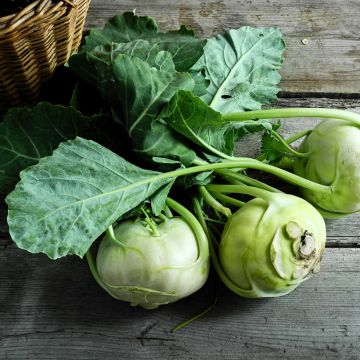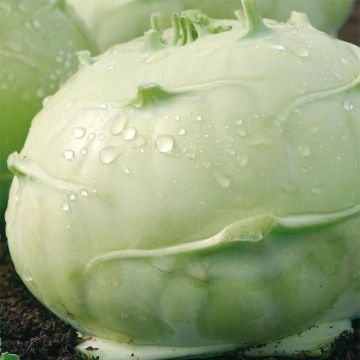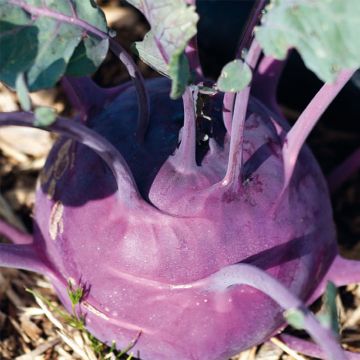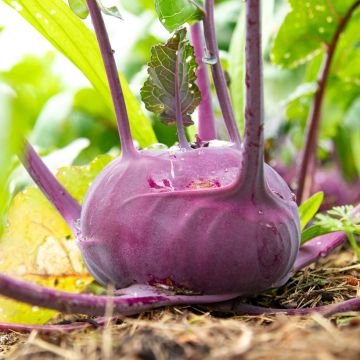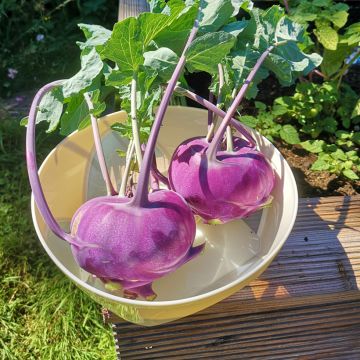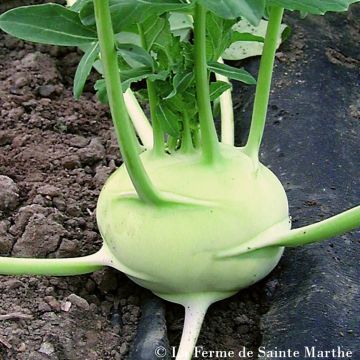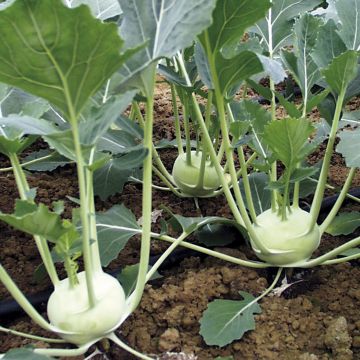
Succeeding in kohlrabi cultivation
All our tips for successful vegetable gardening
Contents
The kohlrabi is a variety of cabbage, grown in the vegetable garden for its swollen stems forming beautiful white, celadon green, or purple bulbs. This ancient vegetable, which has fallen into disuse since the war, like the Jerusalem artichoke and the swede, is actually easy to grow. It offers a fine, sweet, and crunchy flesh that is reminiscent of radish, chestnut, and turnip. Low in calories, packed with fibre, vitamins, and minerals, it has numerous health benefits. Today, this small fleshy bulb is making a grand return to our vegetable gardens and plates! And it is only fair, as this somewhat forgotten cabbage is full of qualities, both in taste and nutrition, and can be enjoyed both cooked and raw. It is sown in spring, grows quickly, and requires almost no care. We harvest its colourful and tasty bulbs from June to November. Discover how to sow and grow, as well as harvest and consume this cabbage that is a bit less demanding than most cabbages!
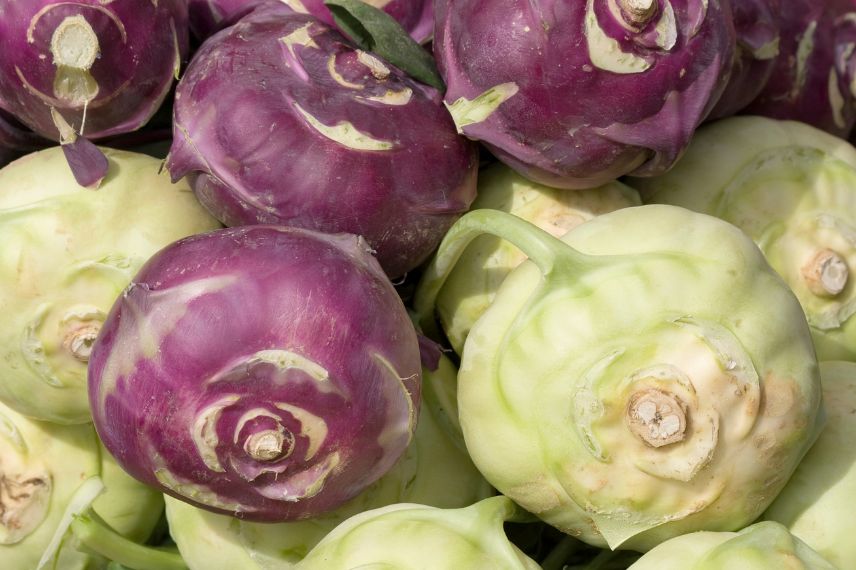
Kohlrabi: a cabbage like no other
The kohlrabi (in Latin brassica oleracea var. gongylodes) is a small, discreet yet tasty cruciferous vegetable belonging to the large family of Brassicaceae (formerly Cruciferae), just like cabbages, cauliflowers, broccoli, and Brussels sprouts. It is sometimes referred to as kohlrabi, Siamese cabbage, turnip cabbage, or simply cabbage turnip. This rather unusual-looking vegetable hails from Europe. Associated with the Second World War and food shortages, during which it replaced the potato that was requisitioned by the Germans, alongside Jerusalem artichokes and rutabagas, it was neglected for decades. Widely consumed in Central Europe since the Middle Ages and in Asia, it has fallen out of favour here since the Occupation. Today, it is making a comeback in our vegetable gardens and regaining its place in the kitchens of some Michelin-starred chefs.
Kohlrabi is distinguished from its relatives by its growth. The fleshy stem, instead of rising like that of other cabbages, remains in the ground where it swells to form a white, pale green, or purple bulb 6 to 20 cm in diameter above the soil level. From this swollen stem, large bluish-green leaves with dentate edges and long petioles emerge. They are arranged in a spiralled pattern around the bulb, giving it a satellite-like appearance. Each bulb weighs between 200 and 300 grams at ripeness. The plant grows to a height of 30 to 40 cm and about 25 cm wide. These bulbs are tender and tasty, with a non-woody flesh. Kohlrabi is a biennial plant that is cultivated as an annual.
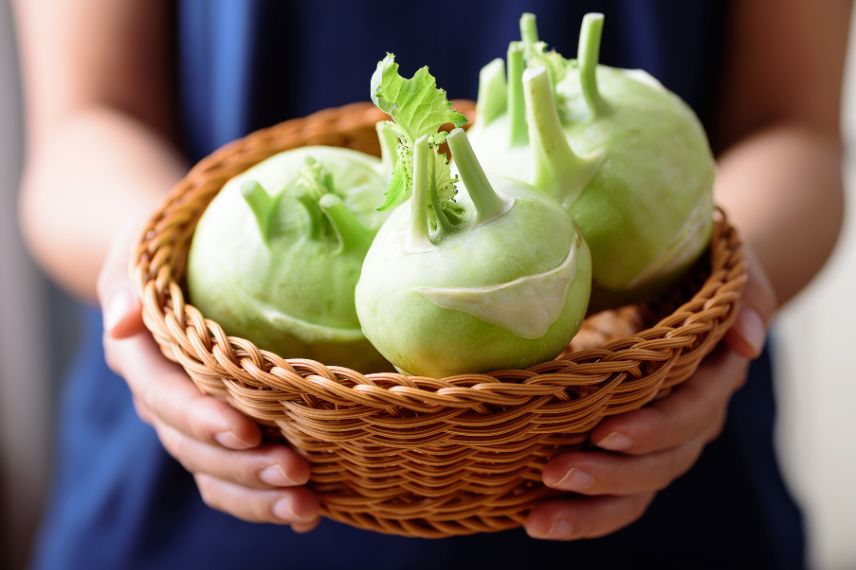
The different varieties of kohlrabi
For our greatest delight, kohlrabi comes in several beautiful varieties, some of which are early. Depending on the harvest period, kohlrabi is referred to as early or seasonal. We recommend the following varieties:
- The ‘Early White Vienna’ Kohlrabi: is a very early variety with rapid development, which produces beautiful white bulbs that are tender and tasty from June.
- The ‘Superschmelz’ Kohlrabi: produces enormous yet tasty bulbs with pale green skin that can weigh up to 10 kg each!
- The ‘Azur Star’ Kohlrabi: is a spectacular early variety that yields beautiful purple bulbs from June. It is resistant to running to seed.
- The ‘Blaro Violet ORGANIC’ Kohlrabi: is surprising as its purple skin reveals a white flesh that is very tasty. It is slightly later than the white kohlrabi and is harvested from July.
- The ‘Lanro White ORGANIC’ Kohlrabi: produces beautiful white bulbs washed with tender green. It is early and resistant to running to seed.
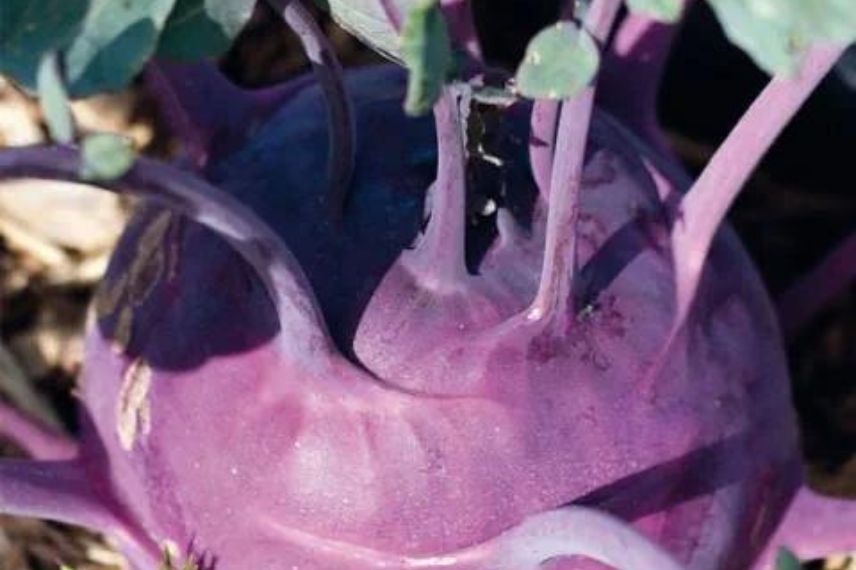
‘Azur Star’ Kohlrabi
Discover other Kohl rabi seeds
View all →Available in 1 sizes
Available in 1 sizes
Available in 1 sizes
Available in 1 sizes
Available in 1 sizes
Available in 1 sizes
Available in 1 sizes
Available in 1 sizes
Available in 1 sizes
Available in 1 sizes
When and how to sow kohlrabi?
Kohlrabi can be sown over a long period, from March to mid-July, depending on the varieties. You can sow every 15 days until mid-summer to stagger the harvests.
Direct sowing in place is possible, but preparing young plants for transplanting is the most commonly used method. Once well-developed, the young plants are installed in the vegetable garden in their final position from mid-April to the end of August. They should be planted in warmed and well-prepared soil: weeded, loosened with a spade or broad fork, then raked with a rake to achieve fine soil.
Preparing your young plants under cover:
- Fill buckets or a seed tray with seed compost
- Sow the seeds at a depth of 1 to 2 cm
- Lightly cover with compost or vermiculite
- Water gently without saturating the substrate
- Keep warm and in light, at a temperature of at least 7°C, maximum 30°C
- Germination generally takes 5 to 14 days
- Thin out by keeping only the most vigorous seedlings
- When they have at least 4 or 5 leaves, transplant them to their final position in the open ground once the frosts have passed
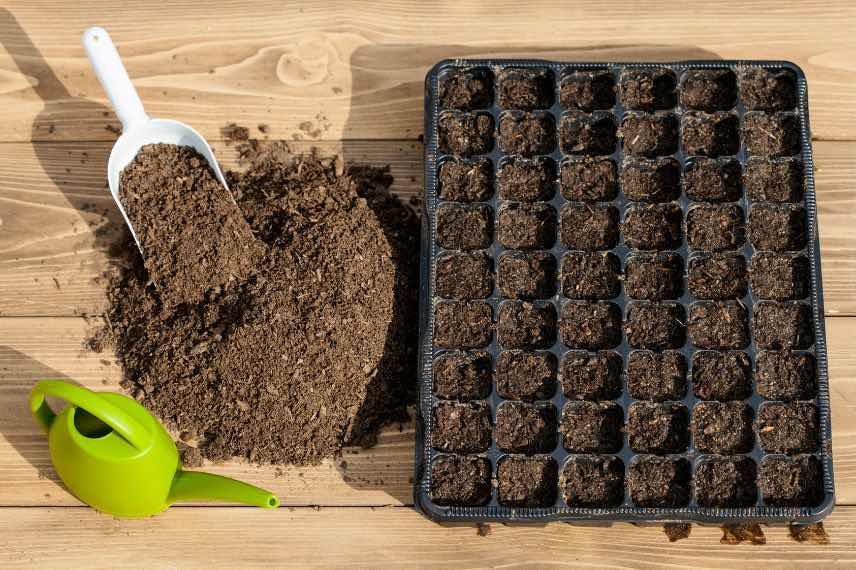
Sowing in open ground:
You can sow directly from April to August, in place or in a nursery, when frost is no longer a concern, in well-crumbled, warmed, and loosened soil.
- Trace furrows 1 to 2 cm deep, spaced about 30 cm apart
- Sow the seeds in rows every 3 cm and cover them with a layer of fine soil
- Firm down and water lightly to avoid displacing the seeds
- Keep the soil moist until germination
- When the young plants are well-developed, thin out by keeping only one plant every 25-30 cm
When and how to plant kohlrabi?
Young plants of kohlrabi are planted in the garden from mid-April to the end of August. Before planting, the soil must be sufficiently warmed, properly amended, and finely worked. Kohlrabi prefers cool, deep, and well-fertilised soils. Like all cabbages, kohlrabi is greedy and requires good base fertilisation and regular moisture. In autumn, remember to amend the soil with a supply of well-rotted compost by spreading about 3 kg per m². If you miss this step, be sure to add a good handful of well-rotted compost to each plant at the time of planting. Seedlings should be transplanted at intervals of 25 to 30 cm in deep furrows of one centimetre. Plan for about 9 to 10 plants/m² and place them in full sun or light shade.
- Loosen the soil well
- Dig a hole corresponding to the volume of the root ball
- Insert your seedlings up to the first true leaves
- Cover with soil
- Firm down and water to keep the soil moist
- To aid establishment, water regularly
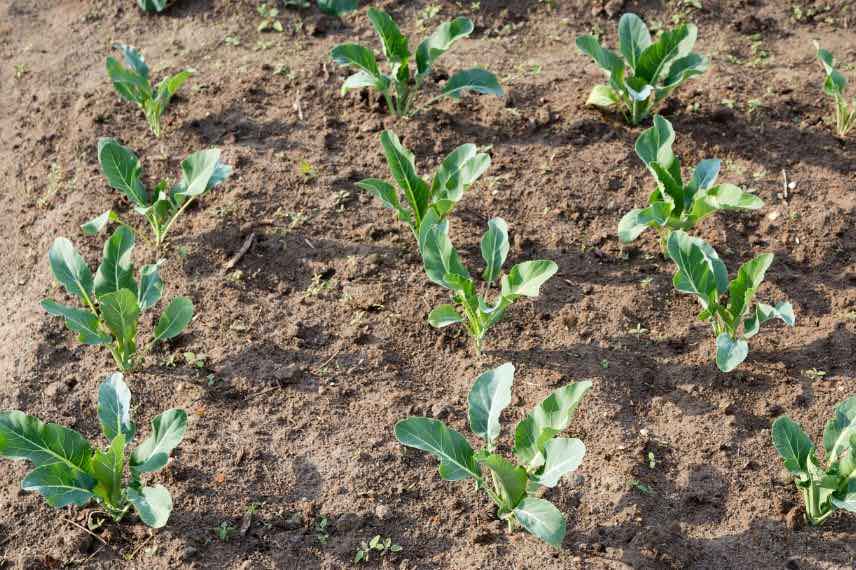
How to care for kohlrabi?
Low-maintenance, kohlrabi does require some attention during the growth period:
- Water regularly but without excess, especially if spring is dry or during periods of intense heat
- Hill up until the installation of mulch to allow kohlrabi to anchor well and for the bulb to develop properly on the surface in the soil
- Hoe regularly
- Mulch (mowings, dead leaves) as kohlrabi prefers soil that remains cool in summer, which will reduce the need for watering
- Protect its bulbs: even though it can survive light frosts, in regions where winter arrives early, a thick mulch is recommended from October onwards.
The harvest of kohlrabi
Turnips are harvested between early July and early November when the bulbs reach 7 to 8 cm in diameter. The harvest takes place on average 75 days, or two to three months after sowing. They can be picked as needed simply by pulling them up. Don’t wait too long to harvest them as the stem quickly becomes fibrous.
Once harvested, these root vegetables can be kept for several days in the vegetable drawer of the refrigerator or for several months in a dark, dry cellar or stored in dry sand. They also freeze very well after being blanched for 5 minutes in salted boiling water.
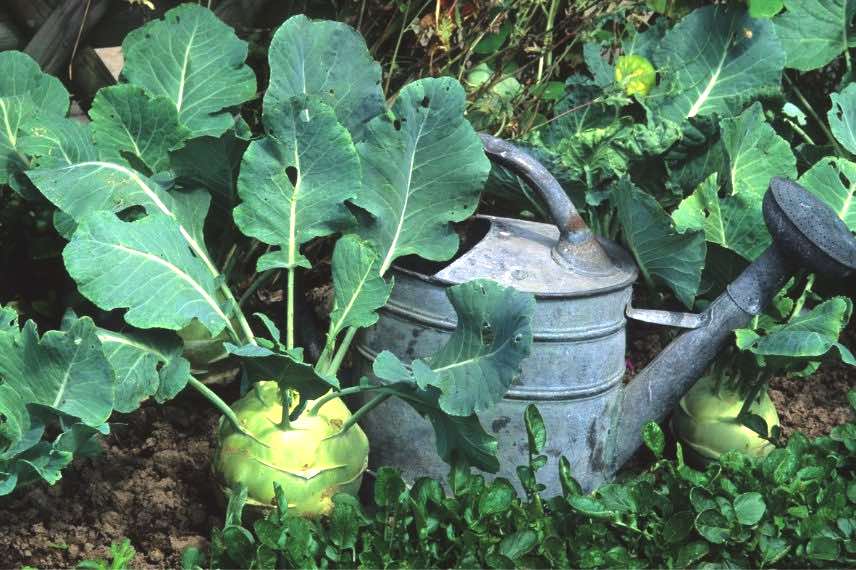
How to consume kohlrabi?
Kohlrabi can be eaten both raw and cooked. Grated or sliced with a mandoline, boiled or steamed, in soup, stir-fried, puréed, or baked with béchamel, or even candied with honey like turnips, in salad, or as carpaccio, or simply eaten raw with salt like radishes, kohlrabi lends itself to a variety of recipes. Low in calories and very rich in vitamins C and B3 and in fibre, it would be a shame to miss out on its many benefits and its subtle nutty flavour! And once cooked, its leaves can be consumed like spinach.
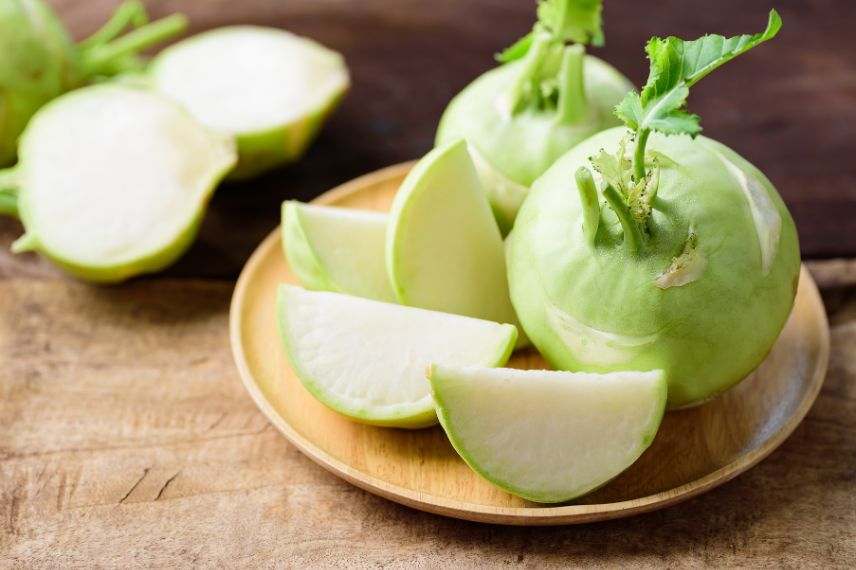
Pests and diseases of kohlrabi
Although resilient, like all cabbages, kohlrabi is susceptible to certain diseases or pests. To combat flea beetles in particular, we recommend using insect netting or a forcing cover to protect your young plants from their appetite, and to read our advice on how to fight against flea beetles.
It is also highly appreciated by slugs and snails. Discover our tips to effectively and naturally combat these invaders. As a preventive measure, also consider planting beneficial flowers near your young plants, such as nasturtium, and maintain a rotation of at least 5 years between two cabbage crops.
→ Learn more in our advice sheet: Diseases and pests of cabbage
To go further
- All our secrets for successful sowing of cabbages are in our guide
- Find more tips for successful cabbage cultivation on our blog!
- Discover our many varieties in our ranges of cabbages
- Subscribe!
- Contents































